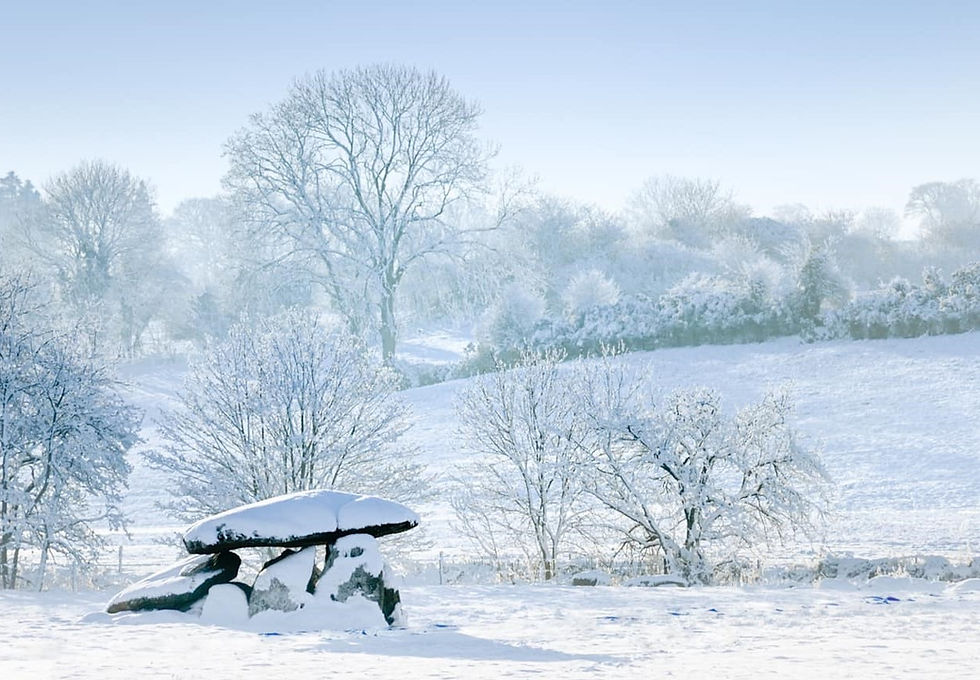The Ancient Pagan Goddesses of Winter
- The heART of Ritual

- Dec 11, 2021
- 4 min read

There are many goddesses associated with this time of the year, so in this post we will take a brief look at some of them, collectively, before a couple of more in-depth posts regarding individual goddesses over the next few weeks. You will notice many common traits, which shouldn't be surprising, but there are also some tantalising and speculative possibilities regarding archaic mother goddesses reaching as far back as the Palaeolithic, in some cases.
If I were to tell you, then, that this first figure appears over mid-winter and leaves presents for good children while punishing the bad, who would you assume I mean? Most likely it would not be the Northern European Goddess Perchta, or the Italian witch Goddess, la Befana. Perchta’s name means ‘bright one’ which may hint at her winter solstice links as the sun is born again and begins a new cycle.
Another line of thought links the origin of Perchta's name to the verb meaning ‘covered’ or hidden.
In this context, there are interesting relationships to folk customs concerning masks and hiding ones identity at this time including wren boys and mummers, for example. We might also see a correspondence to the hidden Otherworld all around us and from where Perchta emerges.
Like many of the Goddesses I have written about on this page, Perchta has more than one aspect to her character. She can appear young and beautiful, as well as old and haggard. Perhaps this is another representation of the dying year giving way to a new cycle after the solstice: the crone aspect of her character signifying the dying year and the youthful aspect representing the new life about to begin.
As well as her physical characteristics being oppositional, so too are the results of encountering her. If you have been good throughout the year, then Perchta may leave you a piece of silver but if you have been bad she is said to tear out your innards are fill your insides with stones and straw!
Perchta also has one swan foot, a motif we see a few times in relation to shape-shifting Goddesses. This is also quite a shamanic-type characteristic and may have been used to signal that Perchta is a much older archetype than her later cultural form suggests. Certainly, Perchta is strongly linked to the great Goddess of Northern Europe, Holda, with other commentators seeing parallels to the Goddess Diana. The association with swans has an Irish connection, too. I know the obvious correspondence is with the story of The Children of Lir but the whooper swans also return to the Boyne Valley at this time of the year which is interesting.
Her later association with witchcraft and the old ways probably goes some way to explaining why Perchta was such a thorn in the side of the Christian church with condemnations issuing forth from the 15th century at least.
Perchta is also believed to be connected to Befana, an Italian Goddess of winter who rides down chimneys bringing good fortune to those who have themselves been good, and leaving coal or a stick to those who have been bad. Although later associated with Christian characteristics and the date of the Epiphany, the historian Carlo Ginzburg compares Befana to the fairy queen, Nicnevin.
This is really interesting as Perchta herself is often considered to be one the alternative leaders of The Wild Hunt, the procession of the dead and good people riding out at winter time. It should also be said that The Wild Hunt tends to have many different procession leaders, depending upon the customs and location. Another well regarded origin for Befana is the Roman deity Strenua, the Goddess of the New Year.
Now, just to get a little bit deeper and complicated with this, there are pathways to follow from Nicnevin to Hecate, the Greek triple Goddess, who herself may be a later form of the Egyptian Goddess of birth and new life, Heqet. Others see Hecate’s beginnings with the Carian people of ancient Anatolia going back to at least 1’300 BCE.
According to Marija Gimbutas, Holda, and by later association, Perchta, may be a Goddess who pre-dates most of Northern Europe’s pantheons, including Odin and Freya, perhaps going all the way back to the Palaeolithic! I would recommend the book, The Living Goddesses, if anyone is more interested in this argument.
In another of her books, Gimbutas writes of Holda that, “[Holle] holds dominion over death, the cold darkness of winter, caves, graves and tombs in the earth….but also receives the fertile seed, the light of midwinter, the fertilized egg, which transforms the tomb into a womb for the gestation of new life."
So, Perchta and Frau Holle (Holda) represent the life of the earth during winter; the evergreens, the holly and mistletoe. Holda is also known as Hlodyn in the Norse Eddas, bringing gifts to women at the time of the Winter Solstice. And this is where we find a very intriguing ancient custom which has largely been forgotten...Stay tuned for the next post! (C.) David Halpin. Image by Eran Fowler


